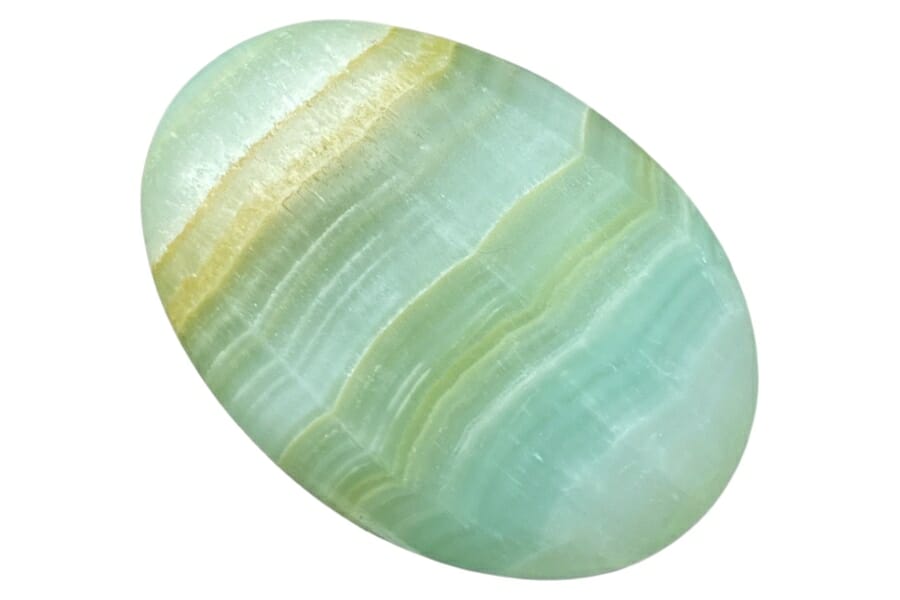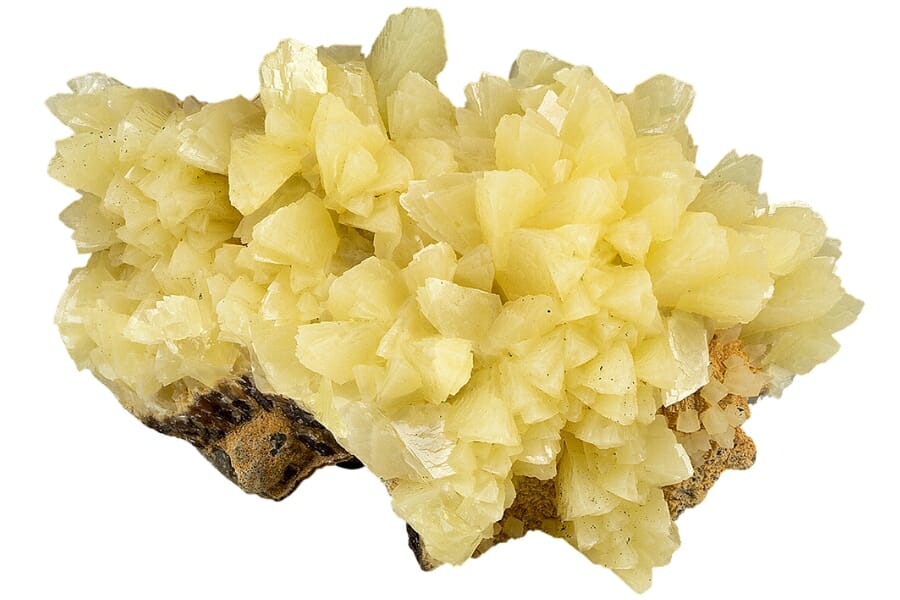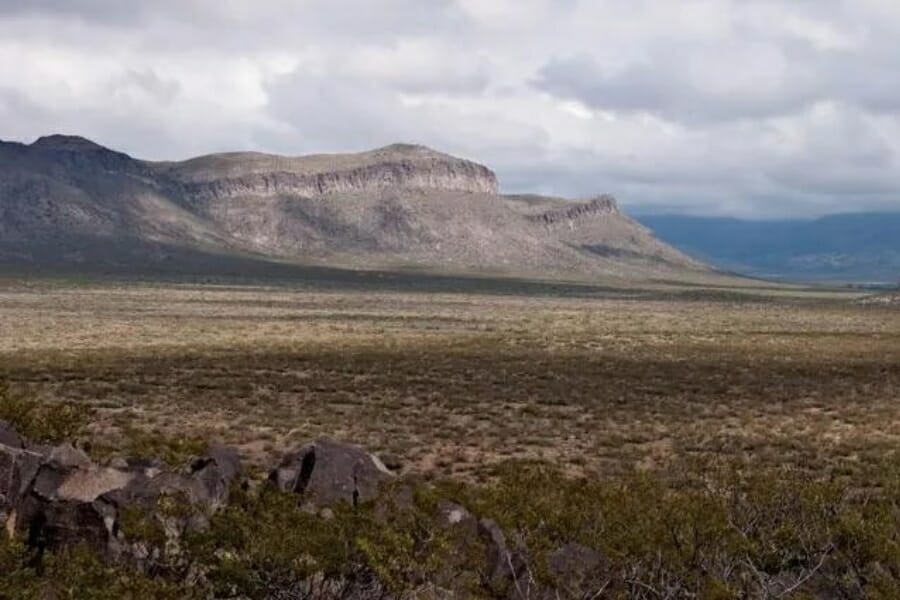Calcite, a carbonate mineral predominantly composed of calcium carbonate (CaCO₃), is fascinating and abundant. Geologists, collectors, and fans worldwide are interested in it because it has unique features like double refraction and many different crystalline forms.
But it’s not enough to know where to look for calcite; you also need to know about its different forms, the minerals often found, and the conditions that make it form.
This article will tell you everything you need to know to join the many people amazed by calcite’s beauty and usefulness.
We will detail the specific parts of the U.S. full of calcite deposits and discuss the best ways to get them out!
What is Calcite?

Calcite is a carbonate mineral mostly made of calcium carbonate (CaCO₃). Calcite is famous for the different crystal forms it can take and for being able to bend light twice as fast.
It can be found in sedimentary rock layers, caves where calcium-rich water crystallizes, and hydrothermal vents.
This mineral is found in large amounts worldwide, especially in places like the United States, China, and Mexico, with a lot of limestone and marble.
Calcite is an important part of the Earth’s carbon cycle and the main ingredient in limestone and chalk. It is often found with minerals like fluorite and quartz.
The different types of Calcite
Calcite is a very flexible carbonate mineral that comes in a huge range of shapes and colors. These are caused mainly by the minerals that are around it when it grows.
This variety shows that calcite is found in many natural places and can grow in various geological conditions.
Blue Calcite

The soothing azure color of blue calcite makes it a beautiful type of common calcite mineral. Its tranquil color, which can be anywhere from pale to deep blue, is caused by impurities or irradiation.
It’s similar to common calcite in that it is not very hard and reacts vigorously with acids. However, it stands out because of its unique color, usually caused by small amounts of copper or cobalt impurities.
Calcite is widely distributed worldwide, but blue calcite is more selectively found, with large deposits in Mexico and parts of the U.S. like Florida.
Compared to more common calcite colors like clear or white, blue calcite is less common and often more sought after by collectors and enthusiasts for its aesthetic.
Cobaltoan Calcite

Cobaltoan calcite, also called cobalt calcite, is famous for the bright pink to magenta colors from cobalt impurities in the carbonate structure. It’s very popular among collectors because it’s very colorful, unlike most types of calcite, which are usually colorless or very light in color.
This mineral has the same physical properties as calcite, like breaking apart into three-dimensional rhombohedral pieces and reacting with acid. But cobaltoan calcite is not as common as regular calcite.
It’s primarily found in places that are good for mining cobalt, like the Democratic Republic of the Congo, Morocco, and some places in Europe, like Slovakia. Its striking color and low availability give it a special appeal, both aesthetically and mineralogically.
Green Calcite

People can tell green calcite apart from other types of calcite by its pale green color. It’s usually found in lush, green places that are signs of growth and change. Small impurities or inclusions, usually green plant matter or chlorite, give it its color.
As with other calcite minerals, green calcite has a rhombohedral cleavage, a vitreous luster, and reacts with acids. Calcite can be found in many places, but green calcite is especially common in the United States and Mexico, especially in Chihuahua.
Compared to the more common colorless or white calcites, green calcite is sought after for its soothing, earthy color. Minerals don’t come much more beautiful than this; people value it for those reasons.
Iceland Spar

Iceland spar is a clear type of calcite famous for being very clear and having strong double refraction properties. Light bends and splits as it passes through this optical property, making two images when looked at from different angles.
It was used in optical instruments in the past, like the Nicol Prism, and it’s said to have helped Vikings find their way. Even though its name makes it sound like it comes from Iceland, there aren’t many large deposits there anymore.
This type of calcite is not as common around the world as its opaque counterparts, but Mexico and some parts of the United States are good places to find it. Iceland spar is a rare and valuable specimen highly sought after by collectors and people interested in optics.
Manganoan Calcite

Manganoan calcite, also called manganese calcite, is easy to spot because it has a beautiful pink color from manganese impurities in its crystal structure.
This type of calcite is different because of its delicate pink-to-peach color, which is different from other types of calcite because of its rhombohedral cleavage and acid reactivity.
Under UV light, it often glows a bright orange pink, which makes it even more appealing. Manganoan calcite is mainly found in places with manganese deposits, like Bulgaria, Italy, and South Africa.
Regular calcite is found all over the world. Manganoan calcite is different from other types of calcite because of its unique color and ability to glow in the dark. This makes it very popular with collectors and enthusiasts.
Yellow Calcite

Calcite comes in many colors, but yellow calcite stands out because it gives off warm, sunlit colors. Its color, which ranges from light lemon to rich gold, comes from iron or manganese that are mixed in.
This mineral has the same basic features as other calcites, such as a rhombohedral cleavage, a vitreous luster, and a unique acid reaction. However, its warm, energizing tones that range from pale lemon to deep amber make it very popular.
Calcite is common worldwide, but yellow calcite is especially common in the US, Mexico, and Belgium. Mineral collectors and fans love it because of its bright color, which makes it stand out from other types of calcite.
Where to find Calcite
Calcite has many forms throughout the United States, with a large and varied geological landscape. The country is a treasure trove for people interested in this versatile mineral.
We will take you to the best places to find calcite and show you the wide range of areas where its different types grow well.
Bisbee, Arizona

Bisbee, Arizona, is a great place to look for calcite because it has a long mining history and many exciting minerals. This area in the Mule Mountains was a popular place to mine copper.
The minerals formed in hydrothermal veins, which also helped calcite grow. Calcite from Bisbee is usually found with other minerals like azurite and malachite. Its color is clear to whitish, sometimes with a hint of blue or green.
Its crystals are valued for their precise, geometric shapes that show off the typical rhombohedral shapes that calcite is known for. Because of the wide range of minerals found there, Bisbee is a great place for collectors and geology fans.
Cave-in-Rock State Park, Illinois

Cave-in-Rock State Park in Illinois is an excellent place for calcite fans to visit because it has historic caves carved into the limestone bluffs of the Ohio River. The rocks in the area are perfect for making calcite crystals, which can be seen lining the inside of the park’s name-bearing cave.
These calcite deposits usually appear as beautiful stalactites, stalagmites, and flowstone formations. Depending on the impurities, the color can range from clear to amber.
The area is also known for its fluorite deposits, and calcite is often found with these colorful crystals, making them more aesthetically and mineralogically valuable.
Lake Superior, Michigan

Lake Superior is great for mineral collectors because it has lots of calcite. Geologically, the area comprises old basaltic bedrock and copper-bearing veins. Calcite crystallizes in the cracks, often with copper and prehnite.
The mineral impurities in this place cause calcite to form in a wide range of colors and shapes, from clear or white to pink and red. People also go looking for “Lake Superior agates” on the shores of Lake Superior.
While they’re looking for these, collectors often find beautiful calcite rocks. The area has a lot of different types of rocks and beautiful scenery, which makes it a great place to find unique calcite formations.
Otero County, New Mexico

Calcite collectors love going to Otero County in New Mexico, which has giant gypsum dunes at White Sands National Park and limestone formations all around.
The area’s unique geology, with its dry climate and karst landscape, makes it a good place for calcite crystals to grow. These crystals can be found in vugs and as linings in rock cracks.
Here, calcite can be transparent to cloudy, and it’s sometimes mixed with other minerals, like fluorite, to make beautiful and valuable specimens for science and art.
People who collect crystals and do research both like the calcite crystals in Otero County because they are clear and have well-formed crystal habits. The beautiful scenery and long geological history make it a great place to look for minerals.
Pugh Quarry, Ohio

Mineralogists and collectors have long praised the exceptional calcite specimens found at Pugh Quarry in Ohio, close to Custar. The quarry was in an area with a lot of limestone and dolomite rock, which made it a great place for calcite to crystallize.
Calcite can be found in this place in several different shapes, from scalenohedral to rhombohedral crystals, and it’s often found with other minerals, such as celestine and fluorite.
The crystals are famous for being very big and having clear to amber colors. Sometimes they have exciting phantoms or inclusions that make them even more valuable.
Even though collectors can’t use the quarry anymore, its history and contributions to the field of mineralogy continue to show how vital the area is geologically.
How to find Calcite
You can look for calcite in a lot of different ways. Every way is a new adventure with a chance to find one of these lovely stones.
Look for associated minerals
It’s more fun to identify calcite when you look at the minerals often found with it, as these minerals can often lead you to deposits with more calcite.
Because calcite can form in many different ways, it’s often found with other minerals such as fluorite, quartz, pyrite, and barite.
In places like the Illinois-Kentucky Fluorspar District, known for its fluorite deposits, calcite is often found nearby. It fills in the gaps in rocks where fluorite crystals used to be.
Use acid test
In geology, the acid test is a well-known way to find calcite by reacting chemically with weak acids like hydrochloric acid. Calcite is mainly made up of calcium carbonate (CaCO3).
When it comes into contact with acid, it reacts by bubbling up and making carbon dioxide (CO2) bubbles. As a result of the acid, the calcium carbonate in the calcite breaks down.
To use this test in the field while looking for calcite, collectors often bring a small bottle of vinegar or a weaker acid like hydrochloric acid in case they are worried about safety.
A drop of acid is put on the surface of a rock that is thought to be calcite when found. A fizzing or bubbling reaction right away shows that calcite is present. This method works best when impurities make it hard to see the calcite or when it’s spread very thinly in the rock.
Observe terrain
To find calcite by looking at the landscape, you need to know the geological conditions where this mineral usually forms. Calcite is generally found in sedimentary settings, especially with lots of limestone and dolomite.
This is because it forms when calcium carbonate-rich solutions freeze solid. Karst landscapes, which have caves, underground streams, and eroded limestone or dolomite structures, are great places to find calcite deposits.
When exploring these areas, look for outcroppings of rocks that look like the elements have worn them down. Calcite in the stones can make them erode in a pattern resembling scallops or rounded edges.
Calcite appears in caves as speleothems like stalactites, stalagmites, and flowstones. You can find calcite in places mined in the past, especially zinc, lead, or copper mines, because it often forms in the hot water from ore deposits.
How to identify Calcite once you find it
Calcites stand out because they are not like other gems in many ways. Let’s talk about how to tell a calcite from other stones when you find one.
What Calcite looks like on the outside
Although the outside of a calcite can look very different depending on the type, here are some general things to look for:
Crystal forms

When calcite is in its most natural, unpolished state, it has many interesting external features that show how complicated the crystal structure is inside. The rhombohedral cleavage is what makes it easy to spot.
Because of the crystal’s internal symmetry, it usually looks like a set of naturally stepped, blocky shapes, like a staircase in three dimensions. The surfaces are usually smooth, but they can have a glassy or dull sheen, depending on where the specimen came from.
Calcite can have striations or grooves along the crystal faces on the outside, and it often twins, creating complicated and intergrown shapes that are both interesting and hard to identify.
Looks like broken glass

The conchoidal fracture and vitreous luster of rough calcite can make it look like broken glass, especially when broken. It doesn’t always break along its natural cleavage planes when calcite breaks.
Instead, it often breaks in a way that looks like broken glass. This breaks the material into sharp pieces with shiny, see-through surfaces that reflect light, like broken glass panes.
Calcite has a Mohs hardness of 3, which is about the same as soft glass and means it breaks more easily than harder minerals. This is why the comparison to broken glass works so well.
Waxy feel

People often say that the outside of rough calcite feels like wax, which is a very useful property for identifying it by touch. If this mineral is not polished or machined, it has a natural shine ranging from vitreous to almost gummy, making it look greasy or waxy.
This feeling is strongest on surfaces with cleavage or on specimens that have just been broken. It looks like the calcite’s surface reflects light in a soft, diffuse way, like candle wax might look when lit.
The waxy look of the mineral often makes it feel softer and more natural to the touch than its actual hardness suggests. This adds another layer of sensory intrigue to its already varied physical traits. How it looks and feels tells you much about calcite’s special place in the mineral world.
What Calcite looks like on the inside
There are times when the inside of the calcite looks a lot like the outside, but the inside is usually more concentrated or bright. These are some things you might see:
Color zone

When you look inside rough calcite, you can see beautiful color zones that show how the mineral formed over time. Color zoning appears as bands or areas of different colors inside a single crystal.
It’s usually easy to see when the crystal is cut in half or broken. These zones range from clear or white to various hues, including pinks, oranges, yellows, blues, and greens.
Each zone shows a different stage of the crystal’s growth, often caused by changes in the crystal’s formation environment, such as mineral impurities, temperature, and pressure.
It’s beautiful to look at, but these color zones also tell you about the geological history of the calcite’s crystalline structure. This makes each specimen a unique work of natural art.
Double refraction

Birefringence, or double refraction, is one of the most interesting optical effects in rough calcite. The light that comes into a piece of calcite is split into two rays that move through the crystal at different speeds and paths.
This makes things seen through the crystal look twice as big. Putting a piece of calcite over a single line of text will make it look like two separate lines.
This feature is most noticeable in transparent, see-through specimens but can be seen in all calcite, no matter its color. Calcite’s internal lattice structure is what gives it this one-of-a-kind optical effect.
This makes it interesting to mineralogists and valuable in optical applications. The internal world of calcite is complicated and symmetrical, and double refraction shows how its crystal structure is both stable and changing.
Luminescence

One beautiful thing about rough calcite that you can’t always see with the naked eye is that it can be luminescent, a display of natural light that can be seen in certain situations.
Some calcite crystals can glow with a strange light in shades of red, blue, green, or white when exposed to ultraviolet (UV) light. This is called fluorescence. Tiny particles, like manganese or organic matter, inside the calcite absorb UV light and then give off visible light again.
This is what makes the calcite glow. Some pieces of calcite also show phosphorescence, which means they glow for a while after the UV light source is taken away.
This inner play of light, which most people overlook daily when they see the mineral, shows calcite’s hidden depth. It shows how it can change and interact with light, adding mystery and scientific interest to its already complex nature.


